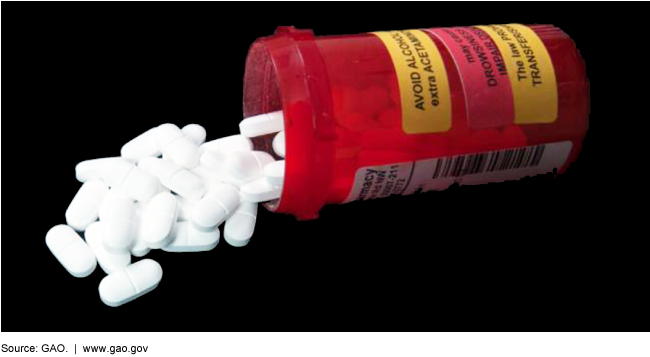Preventing Drug Diversion: Disposal of Controlled Substances in Home Hospice Settings
Fast Facts
When hospice patients die at home, they often leave behind commonly misused controlled substances, such as oxycodone. A 2018 law allows employees of qualified hospice programs to collect and destroy these drugs. This report describes selected home hospices’ disposal practices and the challenges they face.
Hospice representatives identified best practices such as having a disposal witness and using lock boxes to limit drug access. Challenges include the cost of certain disposal methods, a lack of required disposal witnesses, and inconsistencies between state and federal laws over which hospice employees may dispose of controlled substances.

Pills spilling out of a prescription medication bottle
Highlights
What GAO Found
Hospice care helps patients who are terminally ill maintain their quality of life. Most patients get hospice care at home, which typically includes use of controlled substances, including opioids such as oxycodone, to provide pain relief. When hospice patients die at home, they often leave behind unused controlled substances, which can be diverted and misused by anyone with access to them. The Substance Use-Disorder Prevention that Promotes Opioid Recovery and Treatment for Patients and Communities Act (SUPPORT Act), enacted in 2018, allows employees of qualified hospice programs to dispose of unused controlled substances by collecting and destroying the drugs in patients' homes. In addition, some states had laws allowing hospice employees to dispose of patients' unused controlled substances prior to 2018.
Three of the seven hospices GAO contacted operate in states without such laws. Officials from two of these hospices told us their hospices began disposing of patients' controlled substances in their homes following the enactment of the SUPPORT Act in 2018. However, one hospice had not begun disposing of these medications because the state department of health directed it not to do so until a state law granting disposal authority to hospices had been enacted. An official from that hospice said that it continued the practice of leaving the controlled substances in the home and educating family members about how to dispose of the drugs themselves.
Hospice officials we spoke to identified best practices for preventing diversion and disposing of controlled substances. Best practices include prescription drug counts performed by hospice employees to determine if controlled substances are being used properly, use of lock boxes to limit access to controlled substances in situations where diversion is suspected to be a risk, and having a witness for the disposal of unused controlled substances.
The officials also identified challenges their hospice employees have faced when disposing of controlled substances in patients' homes. Challenges include the cost of certain disposal methods, a lack of a witness to the disposal process, and inconsistencies between state laws and federal law concerning which hospice employees may dispose of controlled substances.
The Departments of Justice and Health and Human Services provided technical comments on a draft of this report, which GAO incorporated as appropriate.
Why GAO Did This Study
Misuse of controlled substances continues to be a serious public health problem in the United States. Most commonly misused controlled substances include opioids (such as oxycodone), which are used to treat pain, and central nervous system depressants (such as diazepam), which are used to treat anxiety and sleep disorders. These types of drugs are commonly prescribed for patients in hospice care.
The SUPPORT Act included a provision for GAO to examine disposal of controlled substances in home hospice settings. This report describes selected home hospices' controlled substances disposal practices and the challenges they face in disposing of these substances.
GAO reviewed the SUPPORT Act and other related statutory and regulatory provisions. GAO also interviewed officials from the Centers for Medicare & Medicaid Services, the Drug Enforcement Administration, three national hospice trade associations, two national nurse trade associations, 11 state hospice associations, and seven hospices.
For more information, contact James Cosgrove at (202) 512-7114 or CosgroveJ@gao.gov.
